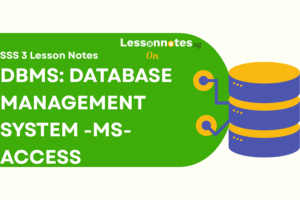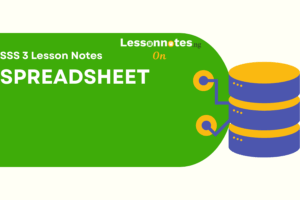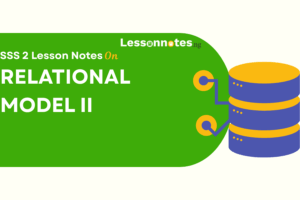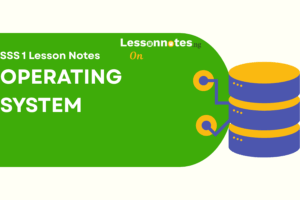Process Of Information Transmission SS1 Data Processing Lesson Note
Download Lesson NoteTopic: Process Of Information Transmission
CHART
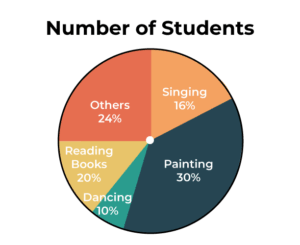
A chart, also called a graph, is a graphical representation of data, in which “the data is represented by symbols, such as bars in a bar chart, lines in a line chart, or slices in a pie chart”.
A chart can represent tabular numeric data, functions or some kinds of qualitative structure and provides different info.
The term “chart” as a graphical representation of data has multiple meanings:
i. A data chart is a type of diagram or graph, that organizes and represents a set of numerical or qualitative data.
ii. Maps that are adorned with extra information (map surround) for a specific purpose are often known as charts, such as a nautical chart or aeronautical chart, typically spread over several map sheets.
iii. Other domain-specific constructs are sometimes called charts, such as the chord chart in music notation or a record chart for album popularity.
iv. Charts are often used to ease understanding of large quantities of data and the relationships between parts of the data. Charts can usually be read more quickly than the raw data that they are produced from. They are used in a wide variety of fields, and can be created by hand (often on graph paper) or by computer using a charting application.
Certain types of charts are more useful for presenting a given data set than others. For example, data that presents percentages in different groups (such as “satisfied, not satisfied, unsure”) are often displayed in a pie chart but may be more easily understood when presented in a horizontal bar chart. On the other hand, data that represents numbers that change over some time (such as “annual revenue from 1990 to 2000”) might be best shown as a line chart.
- Mobile Phone
A mobile phone is a wireless handheld device that allows users to make calls and send text messages, among other features. The earliest generation of mobile phones could only make and receive calls. Today’s mobile phones, however, are packed with many additional features, such as Web browsers, games, cameras, video players and even navigational systems.
A mobile phone may also be known as a cellular phone or simply a cellphone.
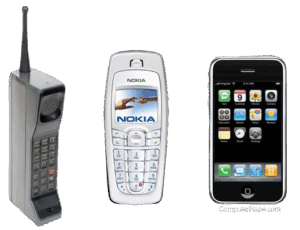
When the first mobile phones were introduced, their only function was to make calls, and they were so bulky it was impossible to carry them in a pocket.
Later, mobile phones belonging to the Global System for Mobile Communications (GSM) network were capable of sending and receiving text messages. As these devices evolved, they became smaller and more features were added, such as multimedia messaging service (MMS), which allowed users to send and receive images.
Most of these MMS-capable devices were naturally equipped with cameras, which allowed users to capture photos with the built-in camera, add captions, and send them to friends and relatives who also had MMS-capable phones.
A mobile phone with highly advanced features is called a smartphone, while a regular mobile phone is known as a feature phone.
A mobile phone typically operates on a cellular network, which is composed of cell sites scattered throughout cities, countryside, and even mountainous regions. If a user happens to be located in an area where there is no signal from any cell site belonging to the cellular network provider he or she is subscribed to, calls cannot be placed or received in that location.
- NEWSPAPER

This is a publication issued at regular and usually close intervals, especially daily or weekly, and commonly containing news, comment, features, and advertising.
- Radio
A radio is a radiation (wireless transmission) of electromagnetic energy through space. The biggest use of radio waves is to carry information, such as sound, by systematically changing (modulating) some properties of the radiated waves, such as their amplitude, frequency, phase, or pulse width. When radio waves strike an electrical conductor, the oscillating fields induce an alternating current in the conductor.
The information in the waves can be extracted and transformed back into its original form.
Radio systems need a transmitter to modulate (change) some properties of the energy produced to impress a signal on it, for example using amplitude modulation or angle modulation (which can be frequency modulation or phase modulation).
Radio systems also need an antenna to convert electric currents into radio waves, and vice versa. An antenna can be used for both transmitting and receiving. The electrical resonance of tuned circuits in radios allows individual stations to be selected. The electromagnetic wave is intercepted by a tuned receiving antenna. A radio receiver receives its input from an antenna and converts it into a form usable for the consumer, such as sound, pictures, digital data, measurement values, navigational positions, etc. Radio frequencies occupy the range from 3 kHz to 300 GHz, although commercially important uses of radio use only a small part of this spectrum.
A radio communication system sends signals by radio. The radio equipment involved in communication systems includes a transmitter and a receiver, each having an antenna and appropriate terminal equipment such as a microphone at the transmitter and a loudspeaker at the receiver in the case of a voice communication system.
5.Telephone
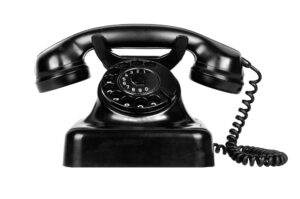
A rotary dial telephone, c.1940s
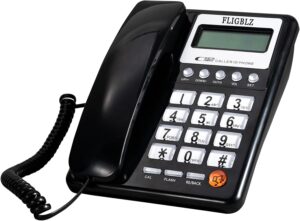
Modern telephones use push buttons
A telephone, or phone, is a telecommunications device that permits two or more users to conduct a conversation when they are too far apart to be heard directly.
A telephone converts sound, typically and most efficiently the human voice, into electronic signals suitable for transmission via cables or other transmission media over long distances, and replays such signals simultaneously in audible form to its user.
In 1876, Scottish emigrant Alexander Graham Bell was the first to be granted a United States patent for a device that produced an intelligible replication of the human voice. This instrument was further developed by many others. The telephone was the first device in history that enabled people to talk directly with each other across large distances. Telephones rapidly became indispensable to businesses, government, and households, and are today some of the most widely used small appliances.
The essential elements of a telephone are a microphone (transmitter) to speak into and an earphone (receiver) which reproduces the voice in a distant location. In addition, most telephones contain a ringer which produces a sound to announce an incoming telephone call, and a dial or keypad used to enter a telephone number when initiating a call to another telephone. Until approximately the 1970s most telephones used a rotary dial, which was superseded by the modern DTMF push-button dial, first introduced to the public by AT&T in 1963. The receiver and transmitter are usually built into a handset which is held up to the ear and mouth during conversation. The dial may be located either on the handset or on a base unit to which the handset is connected. The transmitter converts the sound waves to electrical signals which are sent through the telephone network to the receiving phone. The receiving telephone converts the signals into audible sound in the receiver, or sometimes a loudspeaker. Telephones permit duplex communication, meaning they allow the people on both ends to talk simultaneously.
- Television

A television, commonly referred to as TV, telly or the tube, is a telecommunication medium used for transmitting sound with moving images in monochrome (black-and-white), or in colour, and in two or three dimensions.
It can refer to a television set, a television program, or the medium of television transmission. Television is a mass medium, for entertainment, education, news and advertising.
Television signals were initially distributed only as terrestrial television using high-powered radio-frequency transmitters to broadcast the signal to individual television receivers. Alternatively, television signals are distributed by co-axial cable or optical fibre, satellite systems and via the Internet.
TYPES OF INFORMATION TRANSMISSION
- Wireless
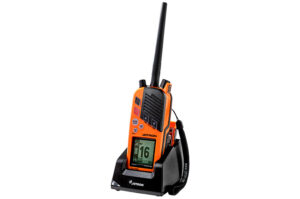
Wireless communication is the transfer of information between two or more points that are not connected by an electrical conductor.
The most common wireless technologies used include
i. Radio
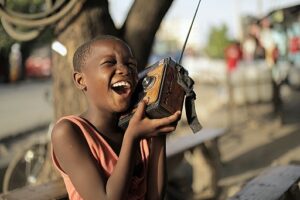
Radio waves distances can be short, such as a few meters for television or as far as thousands or even millions of kilometres for deep-space radio communications.
It encompasses various types of fixed, mobile, and portable applications, including two-way radios, cellular telephones, personal digital assistants (PDAs), and wireless networking. Other examples of applications of radio wireless technology include GPS units, garage door openers, wireless computer mice, keyboards and headsets, headphones, radio receivers, satellite television, broadcast television and cordless telephones.
Somewhat less common methods of achieving wireless communications include the use of other electromagnetic wireless technologies, such as light, magnetic, or electric fields or the use of sound.
ii. Communications satellite

A communications satellite is an artificial satellite that relays and amplifies radio telecommunications signals via a transponder; it creates a communication channel between a source transmitter and a receiver(s) at different locations on Earth.
Communications satellites are used for television, telephone, radio, internet, and military applications. There are over 2,000 communications satellites in Earth’s orbit, used by both private and government organizations.
Wireless communication uses electromagnetic waves to carry signals. These waves require line-of-sight and are thus obstructed by the curvature of the Earth. The purpose of communications satellites is to relay the signal around the curve of the Earth allowing communication between widely separated points.[2] The electromagnetic signals that communication satellites work with have a large spectrum of wavelengths and frequencies.
2. Cable
Cable communication refers to the transmission of data over a wired-based communication technology. Examples include telephone networks, cable television or internet access and fibre–optic communication.
RECEIVER
The receiver in information theory is the receiving end of a communication channel. It receives messages/information from a sender, who first encoded them. Sometimes the receiver is modelled to include the decoder.


